Breast Reduction for Men
What is Male Breast Reduction?
What is gynecomastia?
Gynecomastia is a condition of over-developed or enlarged breasts in men that can occur at any age. The condition can be the result of hormonal changes, heredity, obesity, or the use of certain drugs. Gynecomastia can cause emotional discomfort and impair your self confidence. Some men may even avoid certain physical activities and intimacy simply to hide their condition.
Gynecomastia is characterized by:
- Excess localized fat
- Excess glandular tissue development
- Sometimes excess breast skin
- Presence unilaterally (one breast) or bilaterally (both breasts)
What is Male Breast Reduction?
Plastic surgery to correct gynecomastia is technically called reduction mammaplasty. The procedure reduces breast size, flattening and enhancing the chest contours. In severe cases of gynecomastia, the weight of excess breast tissue may cause the breasts to sag and stretch the areola (the dark skin surrounding the nipple). In these cases the position and size of the areola can be surgically improved and excess skin may be reduced.
Is it right for me?
- You are physically healthy and of relatively normal weight
- You have realistic expectations
- Your breast development has stabilized
- You are bothered by the feeling that your breasts are too large
Adolescents may benefit from surgery, although secondary procedures may be needed in the future should breast development continue.
Surgical correction of gynecomastia is best performed on:
- Men whose condition cannot be corrected through alternative medical treatments
- Healthy individuals who do not have a life-threatening illness or medical conditions that can impair healing
- Non-smokers and non-drug users
- Men with a positive outlook and specific goals in mind for improving the physical symptoms of gynecomastia
Consultation and Preparing for Surgery
During your consultation be prepared to discuss:
Your surgical goals
- Medical conditions, drug allergies, and medical treatments
- Current medications, vitamins, herbal supplements, alcohol, tobacco, and recreational drug use (including steroids)
- Previous surgeries
Your surgeon may also:
- Evaluate your general health status and any pre-existing health conditions or risk factors
- Perform diagnostic testing to determine the underlying cause of gynecomastia; this may include testing of your endocrine function
- Examine your breasts and may take detailed measurements of their size and shape, skin quality, and placement of your nipples and areolas
- Take photographs for your medical records
- Discuss your options
- Recommend a course of treatment
- Discuss likely outcomes of gynecomastia correction and any risks or potential complications
- Discuss the use of anesthesia during your procedure
Prior to surgery, you may be asked to:
- Get lab testing or a medical evaluation
- Take certain medications or adjust your current medications
- Stop smoking
- Avoid taking aspirin, anti-inflammatory drugs, and herbal supplements as they can increase bleeding
The success and safety of your gynecomastia procedure depends very much on your complete candidness during your consultation. You'll be asked a number of questions about your health, desires, and lifestyle. Breast reduction surgery may be performed in an accredited, office-based surgical facility, licensed ambulatory surgical center, or a hospital. Be sure to arrange for someone to drive you to and from surgery and to stay with you for at least the first night following surgery.
Be sure to ask your plastic surgeon questions. It's very important to understand all aspects of your breast reduction. It's natural to feel some anxiety, whether it's excitement for your anticipated new look or a bit of preoperative stress. Don't be shy about discussing these feelings with your plastic surgeon.
The Procedure
Anesthesia
Medications are administered for your comfort during the surgical procedures. The options include intravenous sedation and general anesthesia. Your doctor will recommend the best option for you.
Liposuction
In cases where gynecomastia is primarily the result of excess fatty tissue, liposuction techniques alone may be used. This requires insertion of a cannula, a thin hollow tube, through several small incisions. The cannula is moved back and forth in a controlled motion to loosen the excess fat, which is then removed from the body by vacuum suction. There are various liposuction techniques that may be used; the technique most appropriate in your case will be defined prior to your procedure.
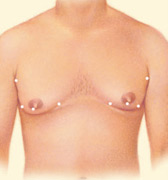

Excision
Excision techniques are recommended where glandular breast tissue or excess skin must be removed to correct gynecomastia. Excision also is necessary if the areola will be reduced or the nipple will be repositioned to a more natural male contour. Incision patterns vary depending on the specific conditions and surgical preference.
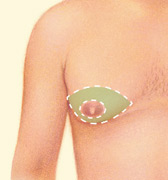
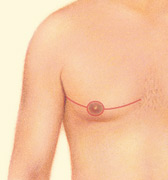
Sometimes gynecomastia is treated with both liposuction and excision.
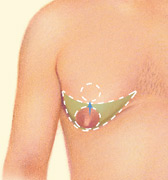
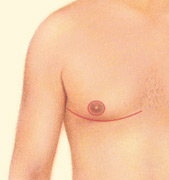
Risks and Safety
The decision to have gynecomastia surgery is extremely personal, and you'll have to decide if the benefits will achieve your goals and if the risks and potential complications are acceptable. You will be asked to sign consent forms to ensure that you fully understand the procedure and any risks and potential complications.
The risks include:
- Reactions to tape, suture materials, glues, topical preparations, or injected agents
- Anesthesia risks
- Bleeding (hematoma)
- Blood clots
- Breast asymmetry
- Breast contour and shape irregularities
- Changes in nipple or breast sensation may be temporary or permanent
- Damage to deeper structures - such as nerves, blood vessels, muscles, and lungs - can occur and may be temporary or permanent
- Deep vein thrombosis, cardiac and pulmonary complications
- Fatty tissue found in the breast might die (fat necrosis)
- Fluid accumulation (seroma)
- Infection
- Persistent pain
- Poor wound healing
- Possibility of revisional surgery
- Unfavorable scarring
Recovery After Surgery
After surgery, dressings or bandages will be applied to your incisions and an elastic bandage or support garment may be used to minimize swelling and support your new chest contour as it heals. A small, thin tube may be temporarily placed under the skin to drain any excess blood or fluid that may collect.
You will be given specific instructions that may include how to care for the surgical site and drains, medications to apply or take orally to aid healing and reduce the potential for infection, specific concerns to look for at the surgical site or in your general health, and when to follow up with your plastic surgeon.
Be sure to ask your plastic surgeon specific questions about what you can expect during your individual recovery period.
- Where will I be taken after my surgery is complete?
- What medication will I be given or prescribed after surgery?
- Will I have dressings/bandages after surgery?
- When will they be removed?
- Are stitches removed? When?
- When can I resume normal activity and exercise?
- When do I return for follow-up care?
It's very important to follow your plastic surgeon's instructions and attend follow-up visits as scheduled.
The final results of the breast reduction procedure are permanent in many cases. However, if gynecomastia resulted from the use of certain prescription medications, drugs (including steroids), or weight gain you must be fully free from these substances and remain at a stable weight in order to maintain your results. Please discuss this with your physician before making changes to your prescription medications.
When you go home
If you experience shortness of breath, chest pains, or unusual heart beats, seek medical attention immediately. Should any of these complications occur, you may require hospitalization and additional treatment.
Following your physician's instructions is essential to the success of your surgery. It's important that the surgical incisions are not subjected to excessive force, swelling, abrasion, or motion during the time of healing. Your doctor will give you specific instructions on how to care for yourself.
Results
The results of your breast reduction surgery are immediately visible. Over time, post-surgical swelling will resolve and incision lines will fade. Satisfaction with your new image should continue to grow as you recover from surgery. The final results of your breast reduction will appear over the next few months. Incision lines are permanent, but will continue to fade over time.
Will there be scars?
Any surgical treatment to correct gynecomastia will require incisions. While most incision lines are concealed within natural contours, some may be visible and are a necessary result of breast reduction surgery.
All scars are permanent, even though some scars may be concealed in the natural contours of the breast. Your improved upper body will likely enhance your self-image and confidence, whether in a shirt and tie, a t-shirt, or baring your chest at the beach.
The practices of medicine/surgery is not an exact science. Although good results are expected from your procedure, there is no guarantee. In some situations, it may not be possible to achieve optimal results with a single surgical procedure.
Another surgery may be necessary:
- To perform additional tightening or repositioning of the breasts
- To treat any complications that may occur
Cost
Prices for gynecomastia surgery can vary. A surgeon's cost may be based on his or her experience, the type of procedure used, and the geographic location of the office. Many plastic surgeons offer patient financing plans, so be sure to ask.
Cost may include:
- Anesthesia fees
- Hospital or surgical facility costs
- Medical tests
- Post-surgery garments
- Prescriptions for medication
- Surgeon's fee
In most cases, correction of gynecomastia is not eligible for insurance coverage. However, each insurance policy varies greatly. Carefully review your policy to determine coverage.
Your satisfaction involves more than a fee:
When choosing a plastic surgeon for gynecomastia surgery, remember that the surgeon's experience and your comfort with him or her is just as important as the final cost of the surgery. Plastic surgery involves many choices. The first and most important is selecting an American Society of Plastic Surgeons (ASPS) member you can trust. ASPS member surgeons meet rigorous standards:
- Board certification by the American Board of Plastic Surgery® (ABPS) or in Canada by The Royal College of Physicians and Surgeons of Canada®
- Complete at least six years of surgical training following medical school with a minimum of three years of plastic surgery residency training
- Pass comprehensive oral and written exams
- Graduate from an accredited medical school
- Complete continuing medical education, including patient safety each year
- Perform surgery in accredited, state-licensed, or Medicare-certified surgical facilities
Do not be confused by other official sounding boards and certifications.
The ABPS is recognized by the American Board of Medical Specialties (ABMS), which has approved medical specialty boards since 1934. There is no ABMS recognized certifying board with "cosmetic surgery" in its name. By choosing a member of The American Society of Plastic Surgeons, you can be assured that you are choosing a qualified, highly trained plastic surgeon who is board-certified by the ABPS or The Royal College of Physicians and Surgeons of Canada.
This procedural information is intended strictly for educational purposes. Only models are depicted in these procedural information pages. It is not intended to make any representations or warranties about the outcome of any procedure. It is not a substitute for a thorough, in-person consultation with a board certified plastic surgeon.
